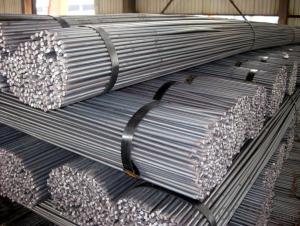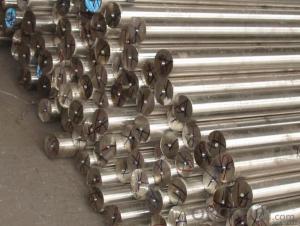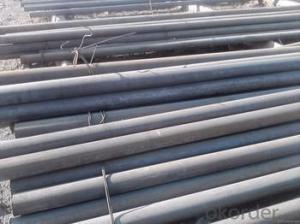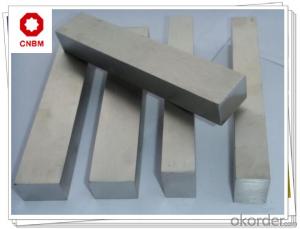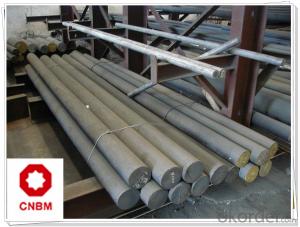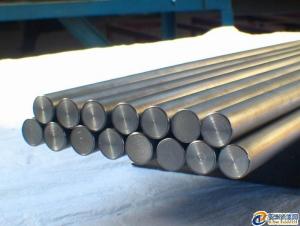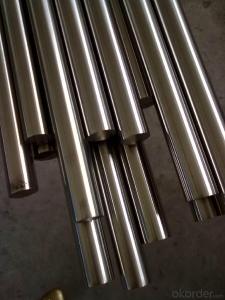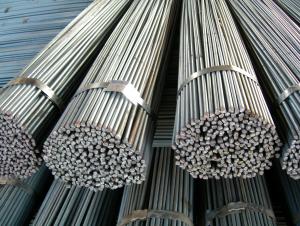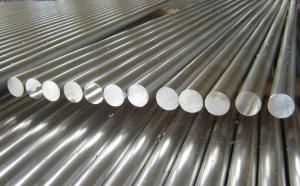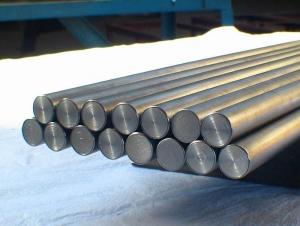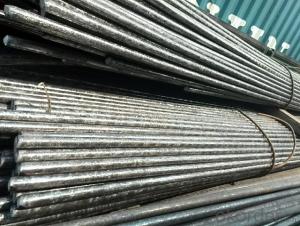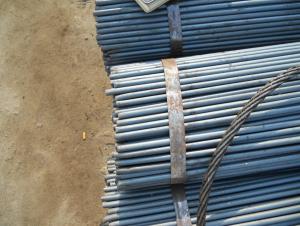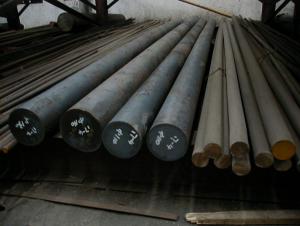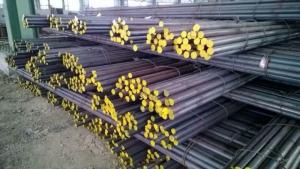Round Bar High Quality Hot Rolled Q195 Q235 5-28MM
- Loading Port:
- China Main Port
- Payment Terms:
- TT or LC
- Min Order Qty:
- -
- Supply Capability:
- -
OKorder Service Pledge
OKorder Financial Service
You Might Also Like
Product Description:
OKorder is offering high quality Round Bar High Quality Hot Rolled Q195 Q235 5-28MMat great prices with worldwide shipping. Our supplier is a world-class manufacturer of steel, with our products utilized the world over. OKorder annually supplies products to European, North American and Asian markets. We provide quotations within 24 hours of receiving an inquiry and guarantee competitive prices.
Product Applications:
1) Suitable for making various strong cutting tool abrasion resistance, impact resistance.
2) Used to produce all kinds of high hard and super hard saw blade, drill, tap, broach, gear hob and various kinds of milling cutter.
3) Used for advanced punching die, screw die, and the toughness and complicated shape of the punch, etc.
4) Is used for cold forging die and drawing mode, etc.
5) Recommended watchcase factory, screw factory and other cold stamping products industry use.
ProdudAvantagesct :
OKorder's Round Bar High Quality Hot Rolled Q195 Q235 5-28MMare durable, strong, and resist corrosion.
Main Product Features:
· Premium quality
· Prompt delivery & seaworthy packing (30 days after receiving deposit)
· Corrosion resistance
· Can be recycled and reused
· Mill test certification
· Professional Service
· Competitive pricing
Product Specifications:
1. Grade: GB, JIS, ASTM, EN
2. Grade: Q235, SS400, A36, S235JR
3. Diameter and mass: As below
Diameter | Mass | Diameter | Mass | Diameter | Mass |
(mm) | (kg/m) | (mm) | (kg/m) | (mm) | (kg/m) |
6 | 0.22 | 22 | 2.98 | 53 | 17.30 |
7 | 0.30 | 24 | 3.55 | 56 | 19.30 |
8 | 0.40 | 25 | 3.85 | 60 | 22.20 |
9 | 0.50 | 26 | 4.17 | 63 | 24.50 |
10 | 0.62 | 28 | 4.83 | 65 | 26.00 |
11 | 0.75 | 30 | 5.55 | 70 | 30.20 |
12 | 0.89 | 32 | 6.31 | 75 | 34.70 |
13 | 1.04 | 34 | 7.13 | 80 | 39.50 |
14 | 1.21 | 36 | 7.99 | 85 | 44.50 |
15 | 1.39 | 38 | 8.90 | 90 | 49.90 |
16 | 1.58 | 40 | 9.86 | 95 | 55.60 |
17 | 1.78 | 42 | 10.90 | 100 | 61.70 |
18 | 2.00 | 45 | 12.50 | 120 | 88.85 |
19 | 2.23 | 48 | 14.20 | 140 | 120.93 |
20 | 2.47 | 50 | 15.40 | 150 | 138.82 |
4. Material: Mild Steel
5. Heat treatment of high quality steel:
Fire: Isothermal annealing temperature is 800 ~ 880 °C, with 10 ~ 20 °C, the furnace cooling to about 600 °C, hardness above HB269.
Preheat temperature: 730-730 °C
Quenching temperature: 1190-1210 °C
Tempering temperature: 540-595 °C
Cold drawn, hardness 285 HBS
Cold drawn after annealing condition, hardness 277 HBS
Quenching methods: oil quenching, air cooling or salt bath quenching
FAQ:
Q1: Why buy Materials & Equipment from OKorder.com?
A1: All products offered byOKorder.com are carefully selected from China's most reliable manufacturing enterprises. Through its ISO certifications, OKorder.com adheres to the highest standards and a commitment to supply chain safety and customer satisfaction.
Q2: How do we guarantee the quality of our products?
A2: We have established an advanced quality management system which conducts strict quality tests at every step, from raw materials to the final product. At the same time, we provide extensive follow-up service assurances as required.
Q3: How soon can we receive the product after purchase?
A3: Within three days of placing an order, we will begin production. The specific shipping date is dependent upon international and government factors, but is typically 7 to 10 workdays.
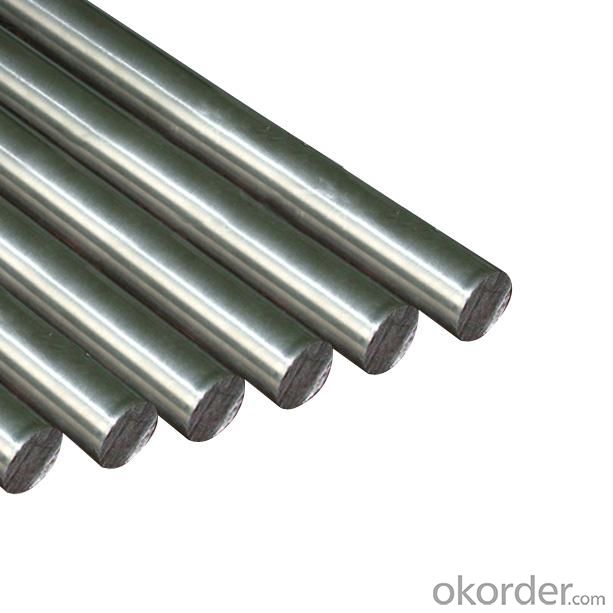
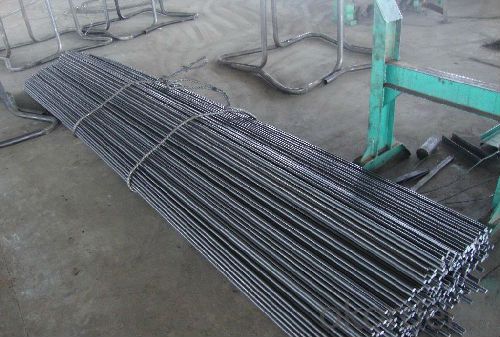
.
- Q: What is the cost of steel round bars compared to other materials?
- The cost of steel round bars can vary depending on the specific type of steel and current market conditions. Generally, steel round bars tend to be more cost-effective compared to other materials such as aluminum or titanium, especially when considering their strength and durability. However, it is always recommended to compare prices and quality from different suppliers to get a more accurate understanding of the cost differences.
- Q: Are steel round bars available in different lengths?
- Indeed, there is a variety of lengths for steel round bars. These bars are designed in diverse lengths to cater to various needs and applications. The range of lengths may differ depending on the supplier or manufacturer. Typically, steel round bars are commonly available in lengths between 6 and 12 feet. However, it is also possible to acquire custom lengths through special requests. This wide range of options grants more flexibility in construction and fabrication projects, as it facilitates the ability to cut or modify the bars according to specific requirements.
- Q: What are the different types of steel round bars used in the automotive suspension systems?
- There are several types of steel round bars used in automotive suspension systems, including solid round bars, hollow round bars, and torsion bars. Solid round bars are commonly used to provide stability and support to the suspension system. Hollow round bars, on the other hand, are used to reduce weight without compromising strength. Torsion bars are another type of steel round bars that are used to provide resistance to twisting forces in the suspension system.
- Q: What are the typical tolerances for steel round bars?
- The typical tolerances for steel round bars can vary depending on the specific requirements of the application or industry. However, there are generally accepted standard tolerances that are commonly used. For diameter, the typical tolerances for steel round bars are usually within a few thousandths of an inch. This means that the actual diameter of the bar can deviate slightly from the specified diameter, but it will still fall within an acceptable range. In terms of straightness, steel round bars are commonly produced with a straightness tolerance that allows for some deviation from a perfectly straight line. The typical tolerance for straightness is usually measured in units of inches per foot or millimeters per meter. This means that the bar may have a slight bend or curve, but it should not exceed the specified tolerance. Surface finish is another important aspect of steel round bars. The typical tolerance for surface finish is usually specified in terms of roughness average (Ra) or surface roughness in micrometers. This tolerance ensures that the surface of the bar is smooth and free from any significant imperfections, such as pits or scratches. It is important to note that these typical tolerances can vary depending on the specific grade or type of steel being used, as well as the intended application. In some cases, tighter tolerances may be required for precision or critical applications, while looser tolerances may be acceptable for less demanding applications. Therefore, it is always recommended to consult the relevant industry standards or specifications to determine the specific tolerances required for a particular steel round bar.
- Q: How do steel round bars compare to glass round bars?
- Steel round bars and glass round bars differ in terms of their properties and applications. Here's a comparison: Strength and Durability: Steel round bars possess exceptional strength and durability, with a high tensile strength that allows them to withstand heavy loads and pressure without deformation. Conversely, glass round bars are fragile and easily break under stress or impact, making them unsuitable for structural applications where strength is crucial. Weight: Steel round bars are considerably heavier than glass round bars. Although this can be advantageous in applications requiring stability and support, it can be a disadvantage in situations where lightweight materials are desired. Corrosion Resistance: Steel round bars are susceptible to corrosion when exposed to moisture or harsh environments. However, they can be safeguarded by coatings or alloys that enhance their resistance to corrosion. In contrast, glass round bars are not prone to corrosion, making them an ideal choice in corrosive environments. Transparency and Aesthetics: Glass round bars have the advantage of transparency, making them suitable for decorative purposes or applications where visibility is important. On the other hand, steel round bars are opaque and lack this characteristic. Thermal Conductivity: Steel round bars have higher thermal conductivity compared to glass round bars. This property makes them more suitable for applications requiring heat transfer or dissipation. Cost: Steel round bars are generally more affordable than glass round bars. The production processes and limited availability of specialized glass types contribute to the higher cost of glass round bars. In conclusion, steel round bars are favored for their strength, durability, and cost-effectiveness, making them suitable for structural applications. Conversely, glass round bars offer transparency, aesthetic appeal, and corrosion resistance, making them suitable for decorative or specific applications where visibility is important. Ultimately, the choice between the two materials depends on the specific requirements and constraints of the project at hand.
- Q: What are the different standards for steel round bars?
- There are several different standards for steel round bars, which vary by country and industry. Some of the commonly used standards include: 1. ASTM A36: This standard is widely used in the United States and specifies the requirements for carbon structural steel, including round bars. It covers the chemical composition, mechanical properties, and dimensional tolerances of the steel. 2. EN 10025: This European standard covers structural steel, including round bars, and is used in many European countries. It defines the chemical composition, mechanical properties, and technical delivery conditions for the steel. 3. JIS G3101: This Japanese standard is commonly used in Asia and specifies the general requirements for hot-rolled steel, including round bars. It covers the chemical composition, mechanical properties, and dimensional tolerances of the steel. 4. DIN 17100: This German standard is widely used in Germany and other European countries. It defines the general structural steels, including round bars, and provides details on the chemical composition, mechanical properties, and technical delivery conditions. 5. BS 970: This British standard covers various types of steel, including round bars, and provides specifications for their chemical composition, mechanical properties, and dimensional tolerances. These are just a few examples of the many standards for steel round bars. It's important to consult the appropriate standard for specific applications to ensure the desired properties and quality of the steel.
- Q: What are the different surface roughness options for steel round bars?
- The different surface roughness options for steel round bars can vary depending on the manufacturing process and specific requirements. Some common surface finishes for steel round bars include smooth, turned and polished, ground, and rough. These options provide different levels of smoothness and surface texture to meet various industrial and aesthetic needs.
- Q: What is the yield strength to tensile strength ratio of a steel round bar?
- The yield strength to tensile strength ratio of a steel round bar, also known as the yield-to-tensile ratio, is an important mechanical property that indicates the material's ability to withstand deformation before it fails under tension. This ratio is typically used to evaluate the ductility and brittleness of a steel bar. In general, the yield strength is the stress at which a material begins to exhibit plastic deformation, while the tensile strength is the maximum stress the material can withstand before it fractures. The yield strength to tensile strength ratio is calculated by dividing the yield strength by the tensile strength. The yield-to-tensile ratio varies depending on the specific grade and composition of the steel being used. However, for most common structural steels, the yield-to-tensile ratio typically falls within the range of 0.6 to 0.8. This means that the yield strength is generally around 60% to 80% of the ultimate tensile strength. A higher yield-to-tensile ratio indicates a more ductile and less brittle steel, as it suggests that the material can undergo substantial plastic deformation before ultimate failure. On the other hand, a lower yield-to-tensile ratio indicates a more brittle steel, which is prone to fracture at lower levels of deformation. It is important to note that the yield-to-tensile ratio is just one of many factors to consider when evaluating the mechanical properties of a steel round bar. Other factors such as hardness, toughness, and elongation also play significant roles in determining the overall performance and suitability of the steel for a particular application.
- Q: How are steel round bars tested for quality and compliance?
- Steel round bars are tested for quality and compliance through various assessment methods such as visual inspection, dimensional measurements, chemical composition analysis, and mechanical property testing. These tests ensure that the bars meet the required standards, strength, and durability for their intended applications.
- Q: How do steel round bars perform under fatigue loading?
- High-quality steel round bars generally exhibit excellent performance when subjected to fatigue loading. Fatigue loading refers to the repetitive application of stress or strain on a material, which can eventually cause failure. The outstanding fatigue strength of steel round bars is well-known. This refers to their ability to withstand cyclic loading without developing cracks or failures. This exceptional fatigue strength can be attributed to the inherent properties of steel, including its high strength, ductility, and toughness. During fatigue loading, steel round bars undergo cyclic stress, resulting in alternating tension and compression. Nonetheless, steel possesses a relatively high endurance limit, also known as the fatigue strength coefficient. This limit determines the maximum stress level that the material can endure without failure, even under cyclic loading. Moreover, steel round bars demonstrate commendable resistance to fatigue crack propagation. In the event that a crack does initiate due to cyclic loading, it is less likely to propagate or grow rapidly in comparison to other materials. This can be attributed to the material's ability to absorb energy and redistribute stress, thus impeding crack growth and preventing failure. Nevertheless, it is essential to consider that the performance of steel round bars under fatigue loading can be influenced by various factors. These factors include the specific type and grade of steel utilized, the manufacturing process, surface conditions, and the applied stress or strain levels. Therefore, it is crucial to adhere to industry standards and guidelines when designing and implementing steel round bars to ensure optimal performance and safety under fatigue loading.
Send your message to us
Round Bar High Quality Hot Rolled Q195 Q235 5-28MM
- Loading Port:
- China Main Port
- Payment Terms:
- TT or LC
- Min Order Qty:
- -
- Supply Capability:
- -
OKorder Service Pledge
OKorder Financial Service
Similar products
Hot products
Hot Searches
Related keywords
